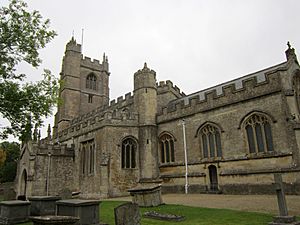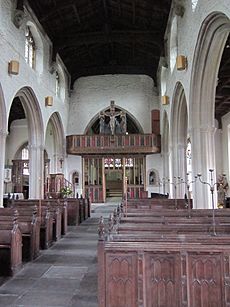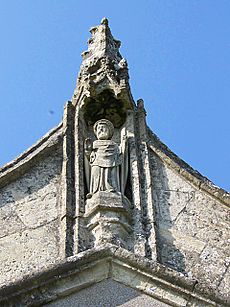Church of St Julian, Wellow facts for kids
Quick facts for kids St Julian's Church, Wellow |
|
|---|---|
 |
|
| Location | Wellow, Somerset, England |
| Built | 1372 |
|
Listed Building – Grade I
|
|
| Designated | 1 February 1956 |
| Reference no. | 32345 |
| Lua error in Module:Location_map at line 420: attempt to index field 'wikibase' (a nil value). | |
The Church of St Julian is a very old church in the village of Wellow, in Somerset, England. Parts of the church's history go back to before the 12th century, but the building you can see today was mostly built in 1372.
Because of its long and important history, it is a Grade I listed building. This is the highest possible rating, given only to buildings that are exceptionally interesting.
Contents
History of the Church
Some people believe the church's story began with the Romans, who had a villa (a large country house) nearby. The church is named after Julian the Hospitaller, a Christian saint. A statue of St. Julian holding an oar can be seen in a special nook, or niche, above the porch.
Early History
Records show that in the year 766, the land at Wellow was given to the monastery of St. Andrew at Wells, which is now Wells Cathedral. Later, in 1117, King Henry I gave the church to a group of priests called Augustinian Canons.
A New Beginning
In 1369, a powerful man named Sir Thomas Hungerford bought the Wellow estate. He decided to rebuild the church, creating the beautiful stone building that stands today. The new church was officially opened, or consecrated, on May Day in 1372 by the Bishop of Bath and Wells.
Amazing Architecture
The church is famous for its stunning design and features that have survived for centuries.
Outside Features
When you approach the church, you walk through a porch with a strong oak door made in the 14th century. On one of the outside walls, you can find a scratch dial, which is a simple, ancient type of sundial used to tell the time for church services.
The church also has a tall west tower that is 84 feet (26 m) high. It was built around 1475 and has strong supports called buttresses and decorative pointy tops called pinnacles. A small, square staircase turret on the corner leads up the tower.
Inside the Church
The main part of the church, called the nave, has a clerestory, which is a row of windows high up on the walls to let in more light. These were added in the 15th century. The stone font, where babies are baptised, is even older, dating back to around 1250.
A special side chapel, called the Hungerford Chapel, has amazing wall paintings from the 15th century showing Christ and his twelve apostles. The chapel also contains several monuments to the Hungerford family, who were so important to the church's history.
The Church Today
The Church of St Julian is part of a group of local churches called The St J's Group. Services are held every Sunday at 10 a.m., and everyone is welcome for refreshments afterwards.
You can find out more about services and events on the church's website: www.stjsgroup.church.
See also
- List of Grade I listed buildings in Bath and North East Somerset
- List of towers in Somerset
- List of ecclesiastical parishes in the Diocese of Bath and Wells



